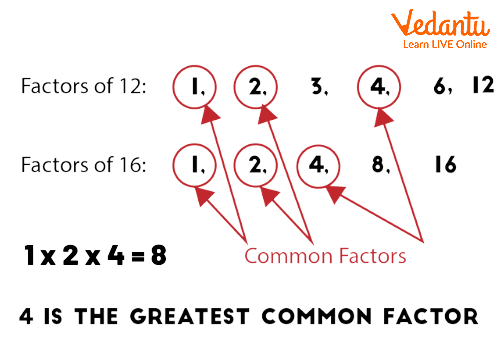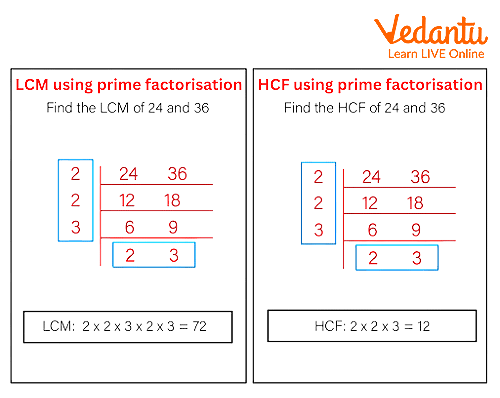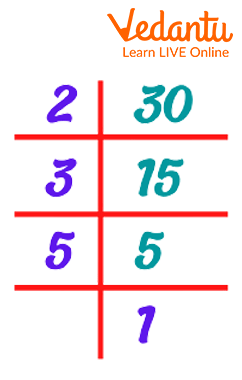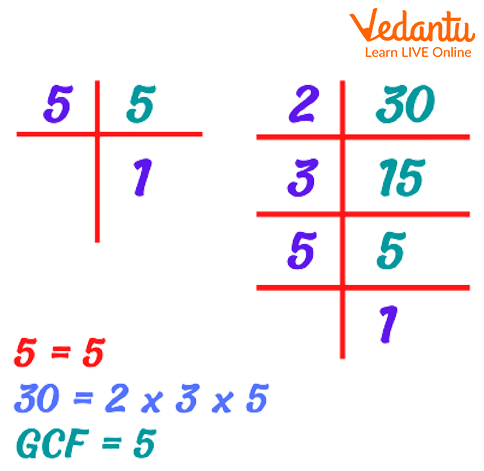




How to Identify and Use Common Factors in Maths Problems
Common factors are those factors which are common in two numbers. Factor can be a whole number, integer. Any decimal number Cannot be a Factor. We can find a common factor by individually finding the factor of two or more numbers and comparing the same factors which are present in two or more numbers, they are called common factors.
What is a Factor?
A factor is a number that divides the other number leaving the remainder as 0. if we multiply that are factors of the product A number can have multiple numbers of factors. Let us take the example of 12. The factors of 12 are 1,2,3,4,6,12. The given number is the factor of 12 because after dividing 12 by any of these numbers the remainder will be 0. We know the very common formula that is \[{\rm{dividend}} = {\rm{divisor}} \times {\rm{quotient}} + {\rm{remainder}}\]. Let’s take an example of a number 12, 2 is a factor of 12 ,So 2 divide 12 Exactly and give 6 as a quotient and 0 as a reminder. 6 is also a factor of 12. So a number can have multiple number of factors like in case of 12 its factors are 1, 2, 3, 4, 6, 12
Factors
Common Factor
Those factors which are common in two numbers are called common factors. We can find out common factors of two numbers by separately finding the factor of each number and then comparing those factors,which are common to both numbers. These factors are called common factors.

Common Factor of Two Number
Factors and its Properties:
Finite number of factors are present for integers
Only 0 and 1 are two numbers which do not have at least two factors.
For a number its factor is always less than or equal to the number
We can find out factors by multiplication and division.
What is Prime Factorisation:
Prime factorisation of a number can be represented as a product of all the prime factors of the number; numbers involved in prime factorisation are prime numbers.ex – factor of \[8 = 2 \times 2 \times 2\] so here the prime factor is 2.
Now let’s discuss the methods from which we can calculate prime factorisation:
Firstly we have to divide given number to the smallest prime number
Repeat the process again by dividing quotient of the above solution by the smallest prime number
We have to repeat this process again and again until the quotient becomes 1.
Then multiply all the prime factors we get from various steps ,the result of that multiplication is called prime factorisation.
What is HCF
HCF is the highest common factor as its name suggests it is the greatest common factor of two or more numbers. Highest common factor is the largest number which can divide both the numbers. Let’s take an example, let a and b are two numbers so the HCF of two numbers is the largest number which can simultaneously divide both a and b. HCF is also called GCF– Greatest common factor.
Example-let’s take two number 12 and 36
Factors of 12–1,2,3,4,6,12
Factors of 36–1, 2,3,4,6,9,12,18,36
The common factor of 12 and 36 are 1,2,3,4,6,12
And the highest common factor of two numbers is 12.
What is LCM
LCM is the least common multiple as its name suggests it is the lowest number that can be divisible by both numbers. Let’s understand this with the help of an example – take two numbers 3 and 5. Multiples are the number that divided by another number will leave the remainder as 0.
Multiples of 3–3,6,9,12,15,18,21,24,27,30
Multiples of 5–5,10,15,20,25,30

Image Showing Lcm and Hcf of Two Numbers
Some Facts about Factors:
There are finite number of factors of a given number
Every number is a factor of itself
Every number has one common factor that is 1
Factor is exact divisor of a number
Solved Questions:
1.Find the prime factors of 30.
We know prime numbers are those numbers which are either multiple of 1 or the number itself.

So prime factors of 30 are 2,3,5
2. Find the common factor of 5 and 30.

GC of 5 and 30
So from matching factors of both 5 and 30 we get the common factor 5
Conclusion:
Here in this article we learned about common factors and how to find out common factors as The name itself suggests that there is a common number which divides two numbers exactly. In this article we also learned about factors, HCF, LCM, prime factorisation and also learnt some interesting facts about factors.
FAQs on Find the Common Factor: Step-by-Step Guide
1. What is a common factor in Maths?
A common factor is a number that divides two or more other numbers exactly, without leaving any remainder. For example, to find the common factors of 12 and 18, we first list the factors of each:
• Factors of 12 are 1, 2, 3, 4, 6, 12.
• Factors of 18 are 1, 2, 3, 6, 9, 18.
The numbers that appear in both lists—1, 2, 3, and 6—are the common factors.
2. What is the step-by-step method to find all common factors?
To find all the common factors for a set of numbers, follow these simple steps:
Step 1: List all the factors for the first number.
Step 2: List all the factors for the second number (and any subsequent numbers).
Step 3: Compare the lists and identify all the numbers that are present in every list. These are the common factors.
3. What is the difference between a Common Factor and the Highest Common Factor (HCF)?
The key difference lies in their names. Common Factors refer to all the factors that are shared by two or more numbers. The Highest Common Factor (HCF), also known as the Greatest Common Factor (GCF), is the single largest number among that list of common factors. For example, the common factors of 20 and 28 are 1, 2, and 4. The HCF is 4.
4. What is the quickest method to find the HCF of large numbers?
The most efficient method for finding the HCF of large numbers is the prime factorisation method. It involves these steps:
1. Prime Factorisation: Break down each number into its prime factors. For example, 56 = 2 × 2 × 2 × 7 and 120 = 2 × 2 × 2 × 3 × 5.
2. Identify Common Primes: Find the prime factors that are common to all the numbers. In this case, both share 2 × 2 × 2.
3. Multiply: Multiply these common prime factors together. So, HCF = 2 × 2 × 2 = 8.
5. Why is finding common factors an important skill in mathematics?
Finding common factors is a fundamental skill with important applications in more advanced topics. Its two primary uses are:
Simplifying Fractions: To simplify a fraction like 12/18 to its lowest terms, you divide both the numerator and the denominator by their HCF, which is 6. This gives you 2/3.
Algebra: In algebra, finding the common factor is the first step in factorising expressions. For example, in the expression 3x + 9, the common factor is 3, allowing you to write it as 3(x + 3).
6. What is the difference between a factor and a multiple?
This is a common point of confusion. A factor is a number that divides another number exactly. Factors of a number are always less than or equal to the number itself and are finite. For example, the factors of 10 are 1, 2, 5, and 10. In contrast, a multiple is the result of multiplying a number by an integer. Multiples of a number are always greater than or equal to the number itself and are infinite. For example, the multiples of 10 are 10, 20, 30, 40, and so on.
7. Can algebraic expressions have common factors, and how do we find them?
Yes, algebraic expressions can have common factors. To find them, you must factorise both the numerical coefficients and the variables. For example, consider the terms 6x²y and 9xy².
First, find the HCF of the coefficients (6 and 9), which is 3.
Next, find the common variables with the lowest power. Both terms have 'x' (lowest power is x¹) and 'y' (lowest power is y¹).
The common factor is the product of these parts: 3xy.
8. What does it mean if the only common factor between two numbers is 1?
If the only common factor between two or more numbers is 1, the numbers are called co-prime or relatively prime. This does not mean the numbers themselves are prime. For instance, 8 (factors: 1, 2, 4, 8) and 9 (factors: 1, 3, 9) are not prime numbers, but they are co-prime because their only common factor is 1.















